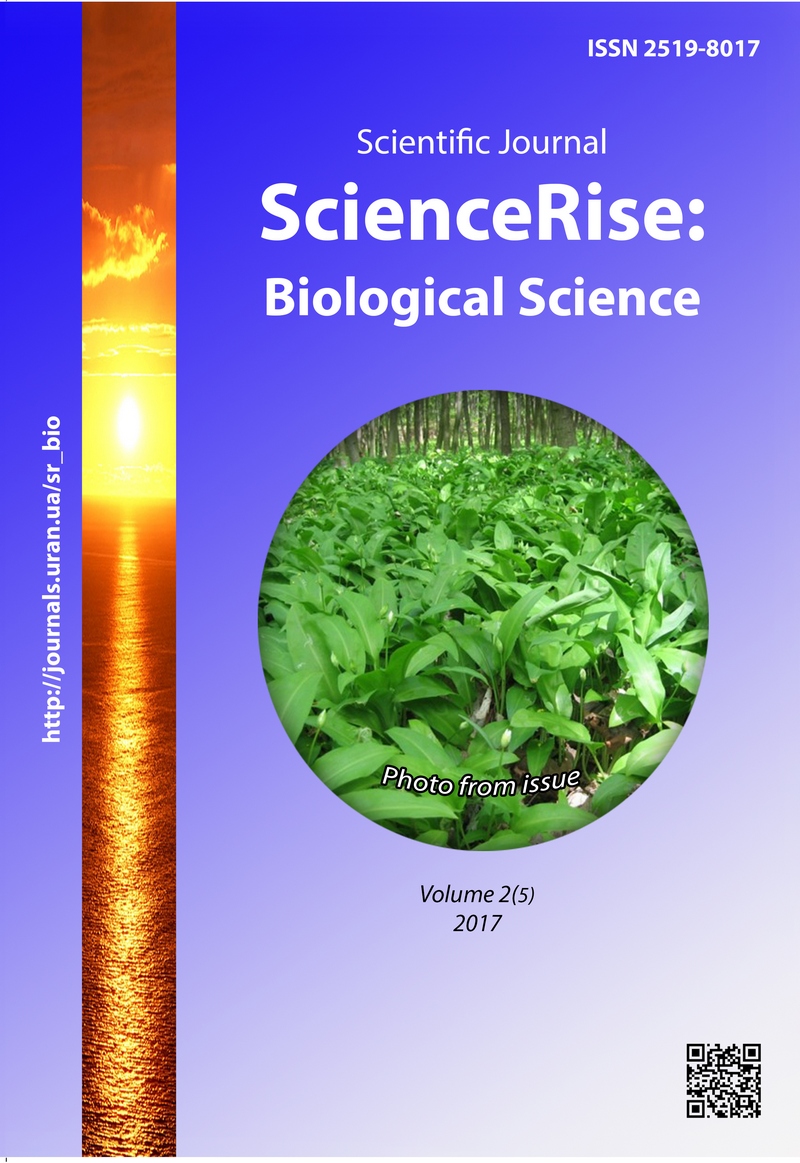The study of Allium Ursinum. L. population in west podillia (Ukraine)
DOI:
https://doi.org/10.15587/2519-8025.2017.99449Keywords:
Allium ursinum L., systematic, geographical, ecological characteristics, population, protection, West PodilliaAbstract
Allium ursinum L. – Caucasian-European forest variety with disjunctive area, late-spring ephemeroid was studied. It is registered in the Red Book of Ukraine (2009).
The aim of research is the study of A. ursinum L. Variety and the condition of its population under conditions of West Podillia.
The study of A. ursinum L. Cenopopulation was carried out in natural conditions on three model populations.
It was established, that under conditions of West Polillia A. ursinum L. is a typical variety of broad-leaved forests. It grows in the groups of Fagetalia sylvatica order, Isopyro thalictroidis-Carpinetum associations of Carpinion betuli union (corydaletosum cavae and brachypodietosum sylvatici sub-associations) and Asperulo odoratae-Fagetum Sougnez et Thill 1959, Asperulo-Fagion Tüxen 1955, Stellario holosteae-Fagetum Onyshchenko 2009 associations of Fagion sylvaticae R.Tx.et Diem. 1936 union. On the territory of NR “Medobory” this variety occurs also in the groups of Tilio platyphylli-Acerion pseudoplatani union (Aceri platanoidis-Fraxinetum excelsioris and Anthrisco nitidi-Aceretum pseudoplatani associations), it grows on friable generous forest soils with the strong layer of bedding under the fresh conditions of moistening.
The populations of this variety are full-member, ecologically stable. They have the left-side spectrum of age conditions.
The seed productivity of variety has the mean indices: PSP – 55,0±6,9 un., ASP – 44,9±7,2, CSP – 81,2 %.
The territory of studied region was remarkable for significant fragmentation and developing, that is why the changes of natural biocenoses took place. There is observed the degradation of flora complex at the expanse of anthropogenic load: deforestation, littering with industrial and everyday waists; cutting of plants for sale; disturbance and destruction of places of growth as a result of open pits activity; recreational use of forests. So the population, appeared in West Podillia needs permanent control and protection
References
- Diduh, Ya. P. (Ed.) (2009). Chervona kniga Ukraini. Rosliny svit [Red Book Ukraine. Plantage]. Kyiv: Globalcolsanting, 59.
- Flora URSR. Vol. 3 (1950). Kyiv: Vid-vo AN URSR, 91–146.
- Omeljchuk, T. Ja. (1962). Systematychnyj sklad ukrajinsjkykh cybulj (rid – Allium). Ukrayins'kyy botanichnyy zhurnal, 19 (3), 67–73.
- Seregin, A. P., Maevskey, P. F. (2014). Sem. Alliaceae Agardh s. l. – Lukovie. Flora sredney polosi Europeiskoy chasti Rossii. Мoscow, 458–463.
- Besser, W. (1810). Catalogue des Plantes du Jardin Botanique de Krzemieniec en Volhynie. Krzemieniec, 87.
- Kuznietsova, H. O. (1958). Flora i roslynnist Podillia yak pamiatka pryrody. Materialy pro okhoronu pryrody na Ukraini. Kyiv: Vyd-vo AN URSR, 1, 55–62.
- Oliiar, H. O. (1994). Okhorona henofondu ridkisnykh roslyn zapovidnyka «Medobory». Okhorona henofondu roslyn v Ukraini. Donetsk, 40–41.
- Liubinska, L. H., Boliukh, V. O. (1997). Flora vyshchykh roslyn natsionalnoho parku «Podilski Tovtry». Ukrayins'kyy botanichnyy zhurnal, 54 (2), 192–197.
- Melnyk, V. I. (2000). Redkie vidy flory ravninnyh lesov Ukrainy. Kyiv: Fitosociocentr, 211.
- Onyshchenko, V. A. (2003). Roslynnist pryrodnoho zapovidnyka «Medobory» ta pytannia yii okhorony. Rol pryrodno-zapovidnykh terytorii Zakhidnoho Podillia ta Yury Oitsovskoi u zberezhenni biolohichnoho ta landshaftnoho riznomanittia. Hrymailiv, 339–358.
- Abduloeva, О. S., Solomaha, V. A. (2011). Fitocenologia. Kyiv: Fitosociocentr, 450.
- Solomakha, V. A. (2008). Syntaksonomija roslynnosti Ukrajiny. Tretje nablyzhennja. Kyiv: Fitosociocentr, 296.
- Ghrant, V. (1991). Evoljucyonnij process. Krytycheskyj obzor evoljucyonnoj teoryy. Moscow: Myr, 488.
- Zlobyn, Ju. A. (2009). Populjacyonnaja ekologhyja rastenyj: sovremennoe sostojanye, tochky rosta. Sumy: Universitetskaya kniga, 263.
Downloads
Published
How to Cite
Issue
Section
License
Copyright (c) 2017 Nataliia Rubanovska

This work is licensed under a Creative Commons Attribution 4.0 International License.
Our journal abides by the Creative Commons CC BY copyright rights and permissions for open access journals.
Authors, who are published in this journal, agree to the following conditions:
1. The authors reserve the right to authorship of the work and pass the first publication right of this work to the journal under the terms of a Creative Commons CC BY, which allows others to freely distribute the published research with the obligatory reference to the authors of the original work and the first publication of the work in this journal.
2. The authors have the right to conclude separate supplement agreements that relate to non-exclusive work distribution in the form in which it has been published by the journal (for example, to upload the work to the online storage of the journal or publish it as part of a monograph), provided that the reference to the first publication of the work in this journal is included.









